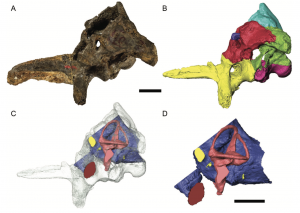 Dinosaurs were famously stupid, but what about Theco, the Bristol dinosaur? In a new study, just published (October 2021), Bristol PhD students Antonio Ballel and Logan King, certainly don’t revise that view; there is no evidence (i’m afraid to say) that Thecodontosaurus was any more brainy (or any more stupid) than any other dinosaur of its size. However, their study does show two things: Theco held its head steady while moving, maintaining a steady gaze, and it had pretty good hearing.
Dinosaurs were famously stupid, but what about Theco, the Bristol dinosaur? In a new study, just published (October 2021), Bristol PhD students Antonio Ballel and Logan King, certainly don’t revise that view; there is no evidence (i’m afraid to say) that Thecodontosaurus was any more brainy (or any more stupid) than any other dinosaur of its size. However, their study does show two things: Theco held its head steady while moving, maintaining a steady gaze, and it had pretty good hearing.
The new study is based on CT scans and detailed digital reconstruction from the amazing Thecodontosaurus braincase in the collections at Yale University. In the image, you can see the braincase (top left), the reconstructed key bones (top right) and images showing the semi-circular canals, highlighted in pink (bottom left and right).
The steady gaze evidence comes from bumps on the side of the Theco brain called flocculi: in modern animals these assist the animals in keeping their head steady as they run and duck and dive, using two responses – one to keep the eyes fixed on any object in their field of view, and the other to keep the head steady. This new finding confirms that Thecodontosaurus was adept at moving bipedally, on its hind legs, and the fixed gaze adaptations would have helped it if it occasionally hunted prey. We’ve always said Theco was a herbivore, and it primarily was, but many early dinosaurs seem to have mixed and matched, and would have grabbed a juicy beetle or small lizard if they had a chance.
It might also seem amazing to be able to estimate the hearing ability of a dinosaur. This can be done using standard formulas based on measuring parts of the braincase and cochlear duct buried in the bone of the skull. It was specialized to hear low and middle frequencies of sounds, similar to other dinosaurs and early birds. These sounds could have included chirping and grunting from other Thecos, and so provides some evidence for group living and some social behaviour where they chattered to each other.
News story here and the new paper is here.


 Dinosaurs were famously stupid, but what about Theco, the Bristol dinosaur? In a new study, just published (October 2021), Bristol PhD students Antonio Ballel and Logan King, certainly don’t revise that view; there is no evidence (i’m afraid to say) that Thecodontosaurus was any more brainy (or any more stupid) than any other dinosaur of its size. However, their study does show two things: Theco held its head steady while moving, maintaining a steady gaze, and it had pretty good hearing.
Dinosaurs were famously stupid, but what about Theco, the Bristol dinosaur? In a new study, just published (October 2021), Bristol PhD students Antonio Ballel and Logan King, certainly don’t revise that view; there is no evidence (i’m afraid to say) that Thecodontosaurus was any more brainy (or any more stupid) than any other dinosaur of its size. However, their study does show two things: Theco held its head steady while moving, maintaining a steady gaze, and it had pretty good hearing.